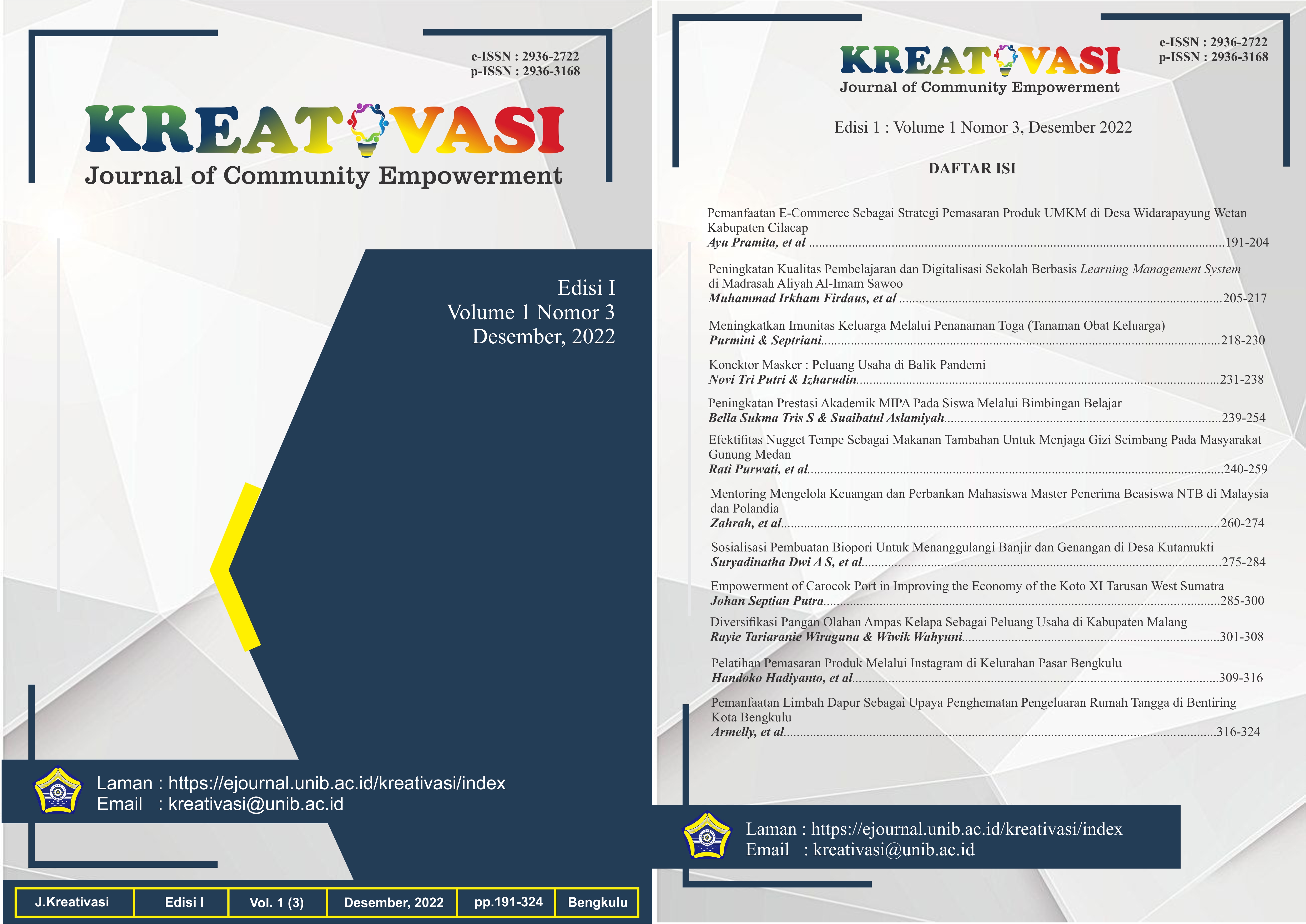Main Article Content
Abstract
Gajahrejo Village, Gedangan sub-district, Malang Regency is a community service location, most of which work as coconut plantation farmers. The abundant harvest results in the low selling price of coconut at post-harvest. The making of VCO (Virgin Coconut Oil) is an attraction for the people of Gajahrejo village as a daily profit, but the manufacture of VCO causes the accumulation of waste or coconut dregs which is not used properly and ends up being wasted. To increase the added value of coconuts, one of them is processing coconuts from VCO manufacturing waste into processed coconut cake products that are suitable as snacks. The limited innovation of human resources causes the low selling value of coconut, so that the utilization of coconut dregs is not maximized. Besides being suitable as a snack for making processed coconut cookies products and coconut lidah kucing cookies, it can also increase the productivity of PKK mothers to process cake products that can be marketed more broadly. The stage in the implementation of the service begins with the preparation of proposals, deepening the problems that exist in Gajahrejo Village, preparing human resources and technology, formulating recipes, testing coconut cakes and coconut lidah kucing cakes, implementing product manufacture in village locations, and preparing reports. Through that all solutions that can be done in the problems that occur are developing coconut processed innovations through training in making coconut cakes and coconut lidah kucing cookies for PKK women in Gajahrejo village and modeling product packaging to increase selling prices in the market. Training for PKK women as a new business opportunity (KUB) and can help support economic stability in the household.
Keywords
Article Details
Copyright (c) 2023 Rayie Tariaranie Wiraguna, Wiwik Wahyuni

This work is licensed under a Creative Commons Attribution-ShareAlike 4.0 International License.
- This statement is a commitment from the author, to respect copyright, both in terms of quoting the work of others, as well as in the use of journal content.
- If needed, the author can send a statement of authenticity of the manuscript. With the receipt of an article by the Editor of Kreativasi - Journal of Community Empowerment, the article submitted has the copyright held by Kreativasi - Journal of Community Empowerment:
- Kreativasi - Journal of Community Empowerment has the right to reproduce and distribute articles that have been published in journals.
- The author is not permitted to publish the same article that has been published in this journal.
References
- Andriani, R., & Afidah, M. (2020). Evaluasi Kegiatan Pengabdian kepada Masyarakat Dosen An Evaluation on Implementation of Community Service Program by Lecturers of Universita Lancang Kuning. Jurnal Pendidikan ilmu-ilmu sosial, 12(1), 271-278
- Arifin, Mohamad, dkk. (2019). “Pemberdayaan Masyarakat Desa Paris Mootilango Gorontalo Melalui Pendampingan Budidaya Bawang Dayak Dan Pembuatan Twh Bawang Dayak”. Gorontalo.
- Cust, T.H.J., Javorcik, B., & V’ezina, P. (2015). Dutch disease resistance: evidence from Indonesian firms. University of Chicago Press Journals.
- Meddiati Fajri Putri, (2014). Kandungan Gizi dan Sifat Fisik Tepung Ampas Kelapa Sebagai Bahan Pangan Sumber Serat. Jurnal Teknologi Busana dan Boga, Vol 1 No.1. Diakses tanggal 08 Mei 2018
- Palupi, H. T. (2012). Pengaruh Jenis Pisang Dan Bahan Perendam Terhadap Karakteristik tepung pisang (Musa Spp). Teknologi Pangan : Media Informasi dan Komunikasi Ilmiah Teknologi Pertanian, 4(1).
- Prasetya, H. N. (2018). Pengolahan ampas kelapa menjadi kue semprong mini untuk peningkatan nilai tambah. Universitas Katolik Widya Karya.
- Rindengan, B., dan Novarianto Hengky. (2005). Virgin Coconut Oil, Pembuatan & Pemanfaatan Minyak Kelapa Murni. Penebar Swadaya. Jakarta.
- Rizky, R. N., & Mavianti. (2019). Keripik Kelapa: Peluang Usaha Baru di Dusun 3 Tanjung Anom, Deli Serdang. Prosiding Seminar Nasional Kewirausahaan, 1(1). https://doi.org/10.30596/snk.v1i1.3633
- Soekardi, Y. (2012). Pengolahan dan pemanfaatan kelapa, menjadi berbagai bahan makanan dan obat berbagai penyakit. CV Yrama Widya. Bandung.
- Standar Nasional Indonesia (SNI). 3751:2009. (2009). Tepung Terigu Sebagai Bahan Makanan. Badan Standardisasi Nasional. Jakarta.
References
Andriani, R., & Afidah, M. (2020). Evaluasi Kegiatan Pengabdian kepada Masyarakat Dosen An Evaluation on Implementation of Community Service Program by Lecturers of Universita Lancang Kuning. Jurnal Pendidikan ilmu-ilmu sosial, 12(1), 271-278
Arifin, Mohamad, dkk. (2019). “Pemberdayaan Masyarakat Desa Paris Mootilango Gorontalo Melalui Pendampingan Budidaya Bawang Dayak Dan Pembuatan Twh Bawang Dayak”. Gorontalo.
Cust, T.H.J., Javorcik, B., & V’ezina, P. (2015). Dutch disease resistance: evidence from Indonesian firms. University of Chicago Press Journals.
Meddiati Fajri Putri, (2014). Kandungan Gizi dan Sifat Fisik Tepung Ampas Kelapa Sebagai Bahan Pangan Sumber Serat. Jurnal Teknologi Busana dan Boga, Vol 1 No.1. Diakses tanggal 08 Mei 2018
Palupi, H. T. (2012). Pengaruh Jenis Pisang Dan Bahan Perendam Terhadap Karakteristik tepung pisang (Musa Spp). Teknologi Pangan : Media Informasi dan Komunikasi Ilmiah Teknologi Pertanian, 4(1).
Prasetya, H. N. (2018). Pengolahan ampas kelapa menjadi kue semprong mini untuk peningkatan nilai tambah. Universitas Katolik Widya Karya.
Rindengan, B., dan Novarianto Hengky. (2005). Virgin Coconut Oil, Pembuatan & Pemanfaatan Minyak Kelapa Murni. Penebar Swadaya. Jakarta.
Rizky, R. N., & Mavianti. (2019). Keripik Kelapa: Peluang Usaha Baru di Dusun 3 Tanjung Anom, Deli Serdang. Prosiding Seminar Nasional Kewirausahaan, 1(1). https://doi.org/10.30596/snk.v1i1.3633
Soekardi, Y. (2012). Pengolahan dan pemanfaatan kelapa, menjadi berbagai bahan makanan dan obat berbagai penyakit. CV Yrama Widya. Bandung.
Standar Nasional Indonesia (SNI). 3751:2009. (2009). Tepung Terigu Sebagai Bahan Makanan. Badan Standardisasi Nasional. Jakarta.
